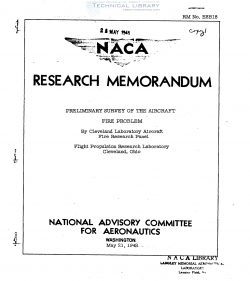naca-rm-e8b18
- Version
- 88 Downloads
- 2.38 MB File Size
- 1 File Count
- April 21, 2017 Create Date
- April 21, 2017 Last Updated
National Advisory Committee for Aeronautics, Research Memorandum - Preliminary Survey of the Aircraft Fire Problem

Information relating to aircraft fires has been. reviewed to
determine what new or further research might lead to a substantial
reduction of the aircraft fire hazard in flight and following
crashes. An examination of fuels, lubricants, and hydraulic fluids
as inflammable liquids is presented herein, together with possible
sources of ignition under the general categories of hot surfaces,
electric sparks and arcs, flames, and hot gases. The literature
on these topics is extensive and a number of organizations are
currently engaged in research and developnent activities on the air—
craft fire problem.
A review of the statistics on aircraft accidents shows that
about 15 percent of all air-carrier accidents are crashes followed
by fire and about 5 percent of all accidents are caused by fire in
flight. In 1946, crash fires caused approximately 70 of 251 deaths
in air-carrier accidents, and fires in flight were responsible for
22 deaths.
From the existing information, it might be concluded that
major reductions in the aircraft fire hazard could be achieved by
the use of low-volatility fuel with inerted fuel tanks, noninflama‘ble
lubricant, and noninflammable hydraulic fluid. Conclusive demonstra-
tion of the apparent benefits in safety to be derived from low-
volatility fuel appears necessary, and serviceability must be
achieved in the engines that will use a low-volatility fuel to at
least the same degree that now exists with aircraft engines.
Extensive research and development must proceed before a satis-
factory noninflamable lubricant will be achieved. Noninflammable
hydraulic fluids are being developed and their effective utilization
should be hastened.
The phenomena of fire extinguishment are incompletely under-
stood and should be studied. Adequate methods of detecting fire or
canbustibles require further development.
There are many existing and potential ignition sources on an
aircraft. h order to establish the appropriate remedial measures
involving these ignition sources, knowledge on the exact nature of
the start and propagation of fires in aircraft must be extended.
Information shows that the exhaust system may be the single most
dangerous ignition source, particularly in a crash or during a
major engine failure, and methods for reducing exhaust—system tem—
peratures should therefore be investigated.
| File | Action |
|---|---|
| naca-rm-e8b18 Preliminary Survey of the Aircraft Fire Problem.pdf | Download |

Comment On This Post